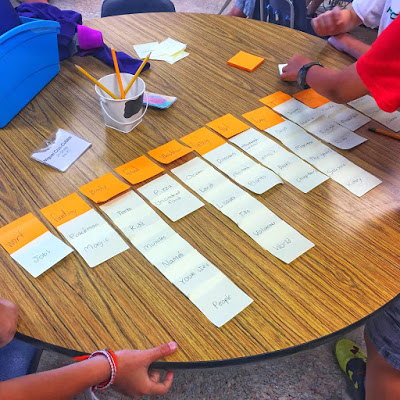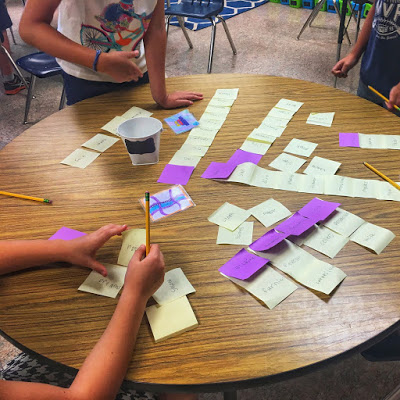Join the VIP Teacher Club!
Teamwork and collaboration! These are important parts of raising a 21st-century learner in the classroom, yet many students do not entirely understand what this it. I stress the importance of teamwork and collaboration throughout the year, but I take time in the beginning of the year to help students truly understand what it means. Throwing around the word “collaboration” can be confusing to students without breaking it down and explaining exactly what it is.
I don’t know about you, but my third-graders always struggle with working as a team in the beginning of the year. My third-graders are easily frustrated and often have the approach of “my way or the highway.” I often get many tears in the beginning of the year as students grapple with understanding how to be part of a bigger team and listening to one another. When a different student disagrees with their idea or opinion, my kiddos often will get sad, angry, or no longer want to contribute to the group. Like anything, teamwork and collaboration is a skill that needs to be practiced!
Below, I highlight an activity that helps explain teamwork to students by giving a large variety of examples in the real world, not only with humans but with inanimate objects, systems, and organizations. Below you will find the steps to this activity. All you need is two sets of Post-It notes per group. It is essentially no-prep and can easily fit into a 45-minute or hour-long window. I usually forgo a day of language arts to fit this it into my schedule, since this lesson deals with writing, critical thinking, and analyzing. I think this activity is perfect on the journey to being a great team member, especially in the beginning of the school year. Read and see if this is something that you would be interested in doing in your classroom!
Step 1: As a whole-group, discuss what collaboration means. It means when individuals respectfully work together for a goal while listening to others to make decisions. We talk about how we can see this in the classroom (examples: doing a group project, deciding how to organize the classroom library, solving a difficult math problem together as a group). We talk about how we need certain skills to do this, including listening and cooperating.
But… can only humans do collaboration? What else in the world works together? How can various components or pieces work together for a common goal? What else in life works together besides humans? Give the example of a grocery store. Who is working together there? The employees must work together to sell the items. The delivery man must work together with the store to deliver the items. The electricity company must work together to make sure there is lighting in the store. Think of all the possibilities!
I then tell students that we are going to be brainstorming various types of collaboration in the world in teams. We talk about how to be a good teammember, and make an anchor chart regarding what it looks and sounds like. For example, it sounds like one voice at a time. It sounds like respectful disagreeing and agreeing (we also write down sentence starters for this). It looks like students listening and making eye contact.

Step 3: Pass out Post-It notes in one specific color, and one Sharpie. I tell my students NO TOUCHING any of the supplies until I say to begin the activity. We also go over Post-It Note basics (for example, do not pull out all the Post-It Notes like an accordion). Only the recorder gets access to the Sharpie and can write.

Step 5: Share! Call on individuals at each table to share a few of their Post-It Notes with the class. Remind the class that if someone writes down their idea that they hear, it is NOT copying. We are learning together and sharing new ideas collaboratively. We are trying to get a large assortment of Post-It Notes. After sharing for a few minutes, I give students an additional two minutes to write more down. Many times sharing jumpstarts their brains and they have a whole bunch more ideas to write down!
Step 6: Discuss how to group and categorize. Basically, students are looking for similarities in their Post-It Notes. Perhaps on their table they notice that on Post-It Notes they wrote down the “circulatory system,” “digestive system”, and “nervous system”. This could go under a bigger umbrella category of the “human body”! Write down the “human body” on a different color Post-It, and line up the similar Post-Its underneath it. What about “tree”, “flower”, and “grass”? This could fall under the bigger umbrella category of “nature”. Demonstrate this to students with your own Post-It Notes on the board or under a document camera.
Step 6: Pass out Post-It Notes in a different color and tell them to begin categorizing! Take 5-10 minutes for this, depending on your students’ abilities. This can be a lot more difficult for students and works on vital critical-thinking skills. Students often have a hard time seeing the forest through the trees, this helps them work on making connections and seeing pieces as a whole.
Step 7: Share student findings and relate this to collaboration! Ask students to share on group, and all the pieces underneath it. Discuss how these things work together. For example, all parts of a circulatory system work together to make blood flow in the human body. However, the circulatory system works with the digestive system, nervous system, etc. to create a healthy body. Everything builds on one another to create something. How is this like individuals in our classroom? What sorts of things can we as individuals do to collaborate on a projector or in the classroom?
Do you have a favorite teamwork or collaboration activity for students? Share it below in the comments!

Hey there, I’m Kelly! I I love helping teachers save time with technology and resources so they have more hours in the day to spend with family and friends. Take a look around to find new ideas that you can implement in your classroom today!
COPYRIGHT © 2024 · Terms and Conditions